| All of these
filters were created out of a single A4 sheet of Baader solar
film from Astro-Physics.
I've included hints and tips that made things easier for me. |
Construction Basics
The Baader film comes with an excellent set of instructions, but
I'll review the essentials. You'll need to create three
basic parts for each filter:
-
Outer cell: The part that faces
the sun and holds the filter.
-
Inner cell: Similar to the outer
cell, this is a ring that holds the filter and fits
inside the ring.
-
Ring: This is the part that fits
around the outside of the tube. It must fit
snugly and be stable.

The Baader instructions show ring construction as layers of
poster board. After some experimentation, I found that a
heavy ring and a thick inner cell made for wide gluing surface
and a more sturdy unit. (Dimensions exaggerated
above.) I also offset the cells to make the outer cell the
"stop" for solar light. The inside hole of the
inner cell didn't need exacting attention, so it was easier to
cut.
|
Hints & Tips
1. Cutting Circles: I used a
drill press and circle cutter (commonly used for cutting mats in
picture frames) to make the inner and outer rings.
2. Materials: I've used brass,
cardboard, hardboard, and CDs with good results. Feel free
to experiment with other available materials. The critical
properties of the cells and the ring are to hold and protect the
filter. Use a material that you are comfortable
manipulating.
3. Air: Make sure to leave some
space between the scope and the ring to allow for air to
move. Otherwise, you may end up tearing the filter
material. |
|

|
Draco Kit scope
This was the scope that got me started. The kit is made of
a simple lens element, PVC pipes, and a film canister
eyepiece. The filter cell is wrapped paper (ala the Baader
film instructions), which seemed too flimsy for regular use, in
my opinion. This is the only filter NOT made from the
single sheet of Baader film. |
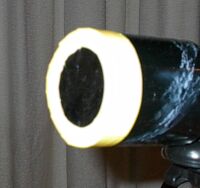
|
|

|
TableTop 76
This was my first experiment in making a cell for the Baader
film. I chose cardboard as the medium, since it was cheap,
easy to machine, and soft (compared to the filter
material.) Brown packing tape "finished" the
outside and hold things together.
While this scope has a very small aperture with a relatively
large secondary and is considered by many to be a toy, it's a
very portable and convenient scope for quick solar
observing. Since the object you're viewing is incredibly
bright, the small aperture does not affect image brightness.
|
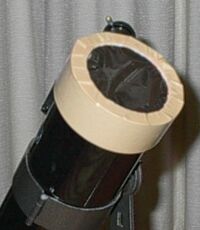 |
| This is the inside of the
filter for the TableTop 76. The filter material is a bit
too loose, but the glue sets quickly and I could not adjust
it. It does not seem to affect the view.
The ring is a chunk of shipping tube that was just a bit bigger
than the TT76. The black strips are pieces of
felt. They serve two purposes - to make a snug fit and to
allow air to exit the filter as you push it in.
|
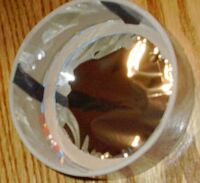
|
|

|
FirstScope80wa
This is perhaps my prettiest filter holder. The ring and
outer facing are made of brass sheeting. The outer facing
was difficult to cut and took three tries to get it right.
The ring was bent 90 degrees to provide a gluing surface and is
relieved with "v" shaped cuts to make forming the
circle much easier. The brass pieces are glued with
epoxy. (Previous tests with solder did not prove
successful and discolored the brass.)
On the inside view, you can see the felt pads added to the ring
to prevent scratching the scope. There are three channels
to allow air to escape.
The filter is held in two cardboard cells with the film glued in
between. The cells are lightly glued to the brass front
ring. The tension isn't quite right on this cell (it's a
bit tight, causing side-to-side wrinkles), but it does not
affect the view. |
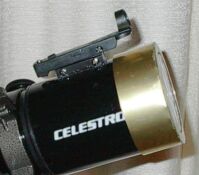
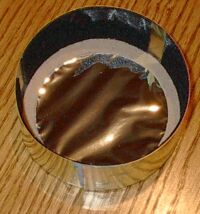
|
|

|
SkyWatcher 102
Since this is the scope that I'm most likely to grab for a quick
view, I wanted something easy, yet different. The results
are (I hope) unique, yet easy to do.
The inner and outer rings are software CDs that I no longer
needed. I used double sided tape (or spray adhesive) to
attach the CDs to a block of scrap wood so I could cut the
circle with my drill press circle cutter. I really like
the look of the multicolor-silver CD holding the silver filter
material. It contrasts nicely with the dark blue scope.
The scope has a ring of Velcro loops near the aperture that I
use to attach focusing masks and the solar filter. It's
key to ensuring that the filter stays in place. Three
"hook" tapes extend from between the two rings to
firmly attach the cell to the scope. A strip of foam makes
the light seal.
I use a double CD case to store the cell. You can see in
this photo that three short dowels extend from the inside right
to better lock the filter in place. |
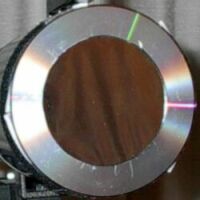 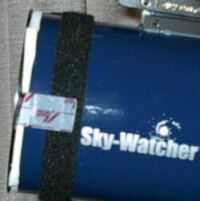 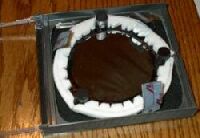
|
|

|
Orion XT8
The most annoying thing about solar observing with Newtonian
scopes is that your eyepiece is at 90º to the bright solar
light. With many eyepieces, the bright solar light ends up
making it difficult to see the dimmer image behind the filter.
I decided to make another unusual filter cell for this
scope. The actual filter is a small three-inch, off-axis
filter. The cell extends off the side of the scope to
provide shade for the observer's eye. There is a hole for
the finder (properly filtered, of course), since this cell hides
the scope's shadow. This is still a rough
work-in-progress.
|
Photos to come. |
|

|
Protecting your Filter
After spending all that time making your filter, you'll want to
protect your filter. There are some keys to protecting a
film solar filter:
1) The film is tough, but can easily be ruined by
scratches or pin-pricks that allow the sun's power to shine
through.
2) The filter should not be distorted, stretched,
strained, or crushed.
3) The ideal filter holder should firmly, but gently
hold the cell, but not touch the film. It should be mostly
air tight to prevent moisture infiltration.
I use a plastic sealing container that comes close to the size
of the filter. I pack tissue paper around the sides to
keep the filter in place. For example, my brass filter for
the FS-80 is shown at right: |

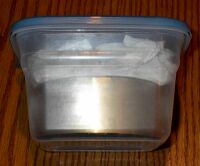 |